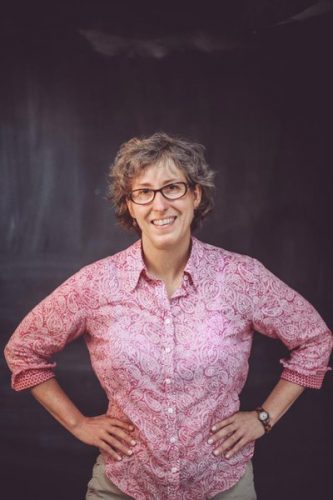
The University of Oregon has long been known for its leadership in green chemistry and responsible product design. A new course taught by Senior Instructor Julie Haack aims to share that philosophy with business students, journalists, marketing students and lawyers.
Chemistry 114 was first taught winter term 2012. Haack intentionally brought in a mix of students: 30 percent were from School of Allied Arts and Architecture, 30 percent were journalism majors and 30 percent were business majors. The students took on the complex challenge of polyvinyl chloride, a material that is widely used in consumer products but is toxic to create and dispose of. “This year students will create a proposal on how to green a product of their choice,” Haack says. “The challenges with product design are complicated and context-specific and resource-dependent. You really need to bring in a diverse team of people to solve these problems.”
The 92 students in the course represent 40 different majors. That means the students work in small groups that may include journalists, graphic designers, architects, business and marketing majors — students that normally would not work together end up utilizing each other’s various areas of expertise to solve a common problem.
Teaching assistant Trevor Gates has a chemistry undergraduate degree and is now studying law. “I’m interested in the course because of the practicality of it,” he says. “These students are working on ideas from the real world and taking them from theory to practice.”
Guest lecturers, such as executives from Nike and instructors from the journalism school, complete the picture of what kinds of information other disciplines would need to embrace a new or a redesigned product. “It helps them make choices about the things they want to buy,” Haack says. “The students talk about how it changes their perspective, and it causes them to act differently because there’s a perspective shift and a behavior shift that goes with that.”
Haack says that chemistry majors have enrolled because they want to know how to talk to journalists, for instance, or how marketing majors approach a new idea. Many of the students have told Haack that they wanted more chemistry knowledge.
“As a chemistry instructor this desire for the high-level chemistry knowledge is pretty exciting,” she says. “They say, ‘I want a deeper understanding.’ This is a really powerful thing.”
The students have numerous reasons for finding the course a powerful draw. Haack says the common theme is deeper knowledge of how green chemistry plays into new business ideas and material selection, enabling them to ask more sophisticated questions. “That’s something I thought was very beneficial,” Gates says. “More knowledge about anything gives you an advantage. It’s a way to expand everyone’s thinking.”